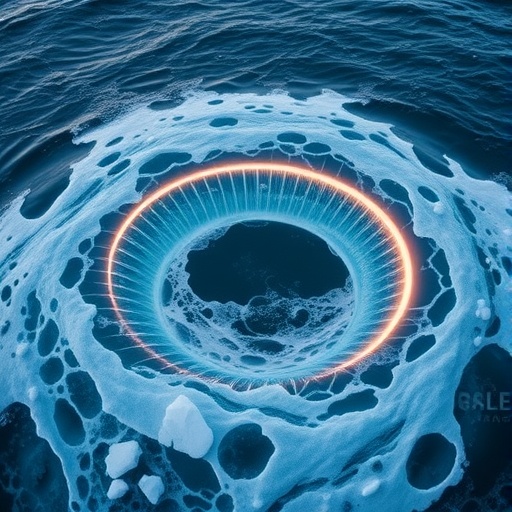The ocean’s surface is a dynamic and ever-changing environment, where countless processes continuously influence the distribution of heat, nutrients, and marine life. A new study published in Nature Communications by Dong, Zhou, McWilliams, and colleagues brings fresh perspective to one of the ocean’s most enigmatic phenomena: the formation of warm rings within mesoscale eddies, even amid a larger, colder straining oceanic environment. This revelation not only deepens our understanding of physical oceanography but also carries profound implications for climate modeling and marine ecosystems.
Mesoscale eddies are large, swirling water masses, typically ranging from tens to hundreds of kilometers in diameter. They act as the ocean’s weather systems, circulating heat, salt, and nutrients, often persisting for months to years. In regions where ocean currents create complex flow patterns known as cold straining, one would expect the eddies to be dominated by cooler temperatures. However, the new research unveils a paradoxical presence of warm rings within these cold-stressed waters, challenging long-standing assumptions about oceanic thermal structures.
At the heart of this discovery lies a sophisticated interplay between the ocean’s mechanical forces and thermal dynamics. Through advanced satellite imagery analysis combined with in situ measurements, the team traced how mesoscale eddies, despite existing in a broad environment of cold straining, could generate coherent warm cores or rings. These warm rings are distinct thermal anomalies, often harboring trapped heat that remains insulated from the immediate surroundings, contributing to a patchwork of thermal heterogeneity across the ocean’s surface.
The process steering the emergence of warm rings begins with the interplay of eddy kinetic energy and the background straining field. The researchers argue that as the cold straining environment stretches and deforms the eddy, nonlinear interactions cause segments of warmer water to be pinched off and encapsulated within the eddy’s vortex. This encapsulation permits the persistence of warmer temperature parcels that are dynamically isolated from the colder, straining exterior flow.
Such findings elevate our comprehension of ocean mixing processes. Traditionally, cold straining regions have been viewed as having efficient vertical and horizontal mixing, dispersing heat and reducing thermal gradients. Yet, the identification of warm rings suggests pockets of reduced mixing and enhanced stability, preserving localized heat anomalies. This challenges existing ocean turbulence models and calls for revising parameterizations used in global climate simulations.
Underlying these observations is a detailed analysis of vorticity and strain rates derived from satellite altimetry data. The researchers employed novel numerical simulations that couple mesoscale ocean dynamics with thermodynamic modules. This allowed them to replicate and predict the formation and lifespan of warm rings under various strain intensities and oceanic conditions. Their models suggest that such warm rings can persist for weeks to months, influencing local ocean-atmosphere interactions.
The ecological ramifications of warm rings are equally significant. Warmer water blobs within otherwise colder regimes could create microhabitats favorable to a variety of marine species, affecting biodiversity and biological productivity. These thermal refuges could act as oases during colder seasons, altering migration patterns and nutrient cycling in ways previously underestimated by marine biologists.
Furthermore, the presence of warm rings embedded in cold environments may modify the local sea surface temperature (SST) patterns, impacting atmospheric circulation and weather phenomena. Since SST is a critical component in driving air-sea interactions, these anomalies may subsequently influence regional climate events such as fog formation, storm development, and precipitation patterns.
From a climatological standpoint, accurately representing these warm rings helps improve predictions of ocean heat content and its redistribution. Given that the ocean stores more than 90% of the Earth’s excess heat from global warming, understanding fine-scale thermal structures is imperative for refining climate sensitivity and feedback mechanisms in Earth system models.
The methodology of this research combines high-resolution satellite remote sensing with an integrative modeling framework, enabling unprecedented insight into mesoscale ocean structures. By focusing on the coupling of physical oceanographic metrics with thermal mapping, the study bridges a gap between observed ocean dynamics and theoretical fluid mechanics in natural marine settings.
Dong and colleagues’ investigation also emphasizes the importance of spatiotemporal scales when studying ocean phenomena. Mesoscale processes, often overlooked in broader ocean circulation studies, show remarkable complexity and influence in the intricate fabric of the global ocean system. It becomes clear that to comprehend larger oceanic and atmospheric interactions, one must delve into these localized, yet potent, events.
The implications of this research are expansive. From improving fisheries management, as biological communities respond sensitively to temperature anomalies, to enhancing the precision of satellite SST algorithms by accounting for submesoscale and mesoscale structures, the study paves the way for multidisciplinary advancements.
Looking forward, the authors propose further research into the mechanistic drivers behind the transition from warm cores to the eventual dissipation under varying environmental stresses. Additionally, integrating chemical and biological sensors could shed light on the biogeochemical impacts of these thermal rings, enriching the multidimensional view of ocean eddies.
In conclusion, this pioneering study redefines the thermal landscape of mesoscale eddies, revealing that warm rings can form and thrive even within cold, straining ocean regions. By dissecting the complex fluid dynamics and thermodynamics at play, it opens new frontiers in ocean science and climate research, reminding us of the ocean’s profound intricacy and the continuous surprises it holds beneath the waves.
Subject of Research: Warm rings formation within mesoscale eddies in cold straining oceanic environments
Article Title: Warm rings in mesoscale eddies in a cold straining ocean
Article References:
Dong, H., Zhou, M., McWilliams, J.C. et al. Warm rings in mesoscale eddies in a cold straining ocean. Nat Commun 16, 9252 (2025). https://doi.org/10.1038/s41467-025-64308-y
Image Credits: AI Generated




